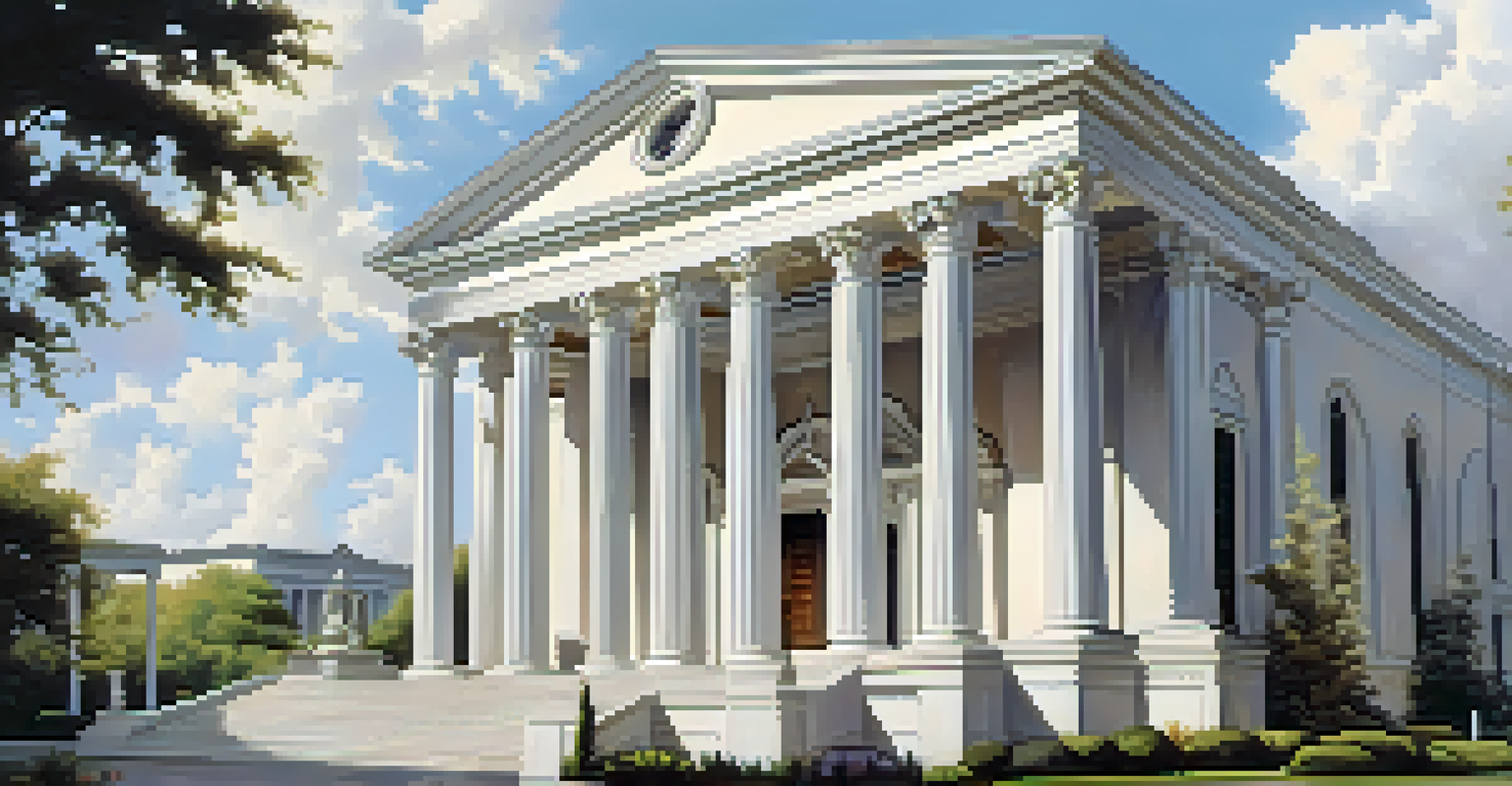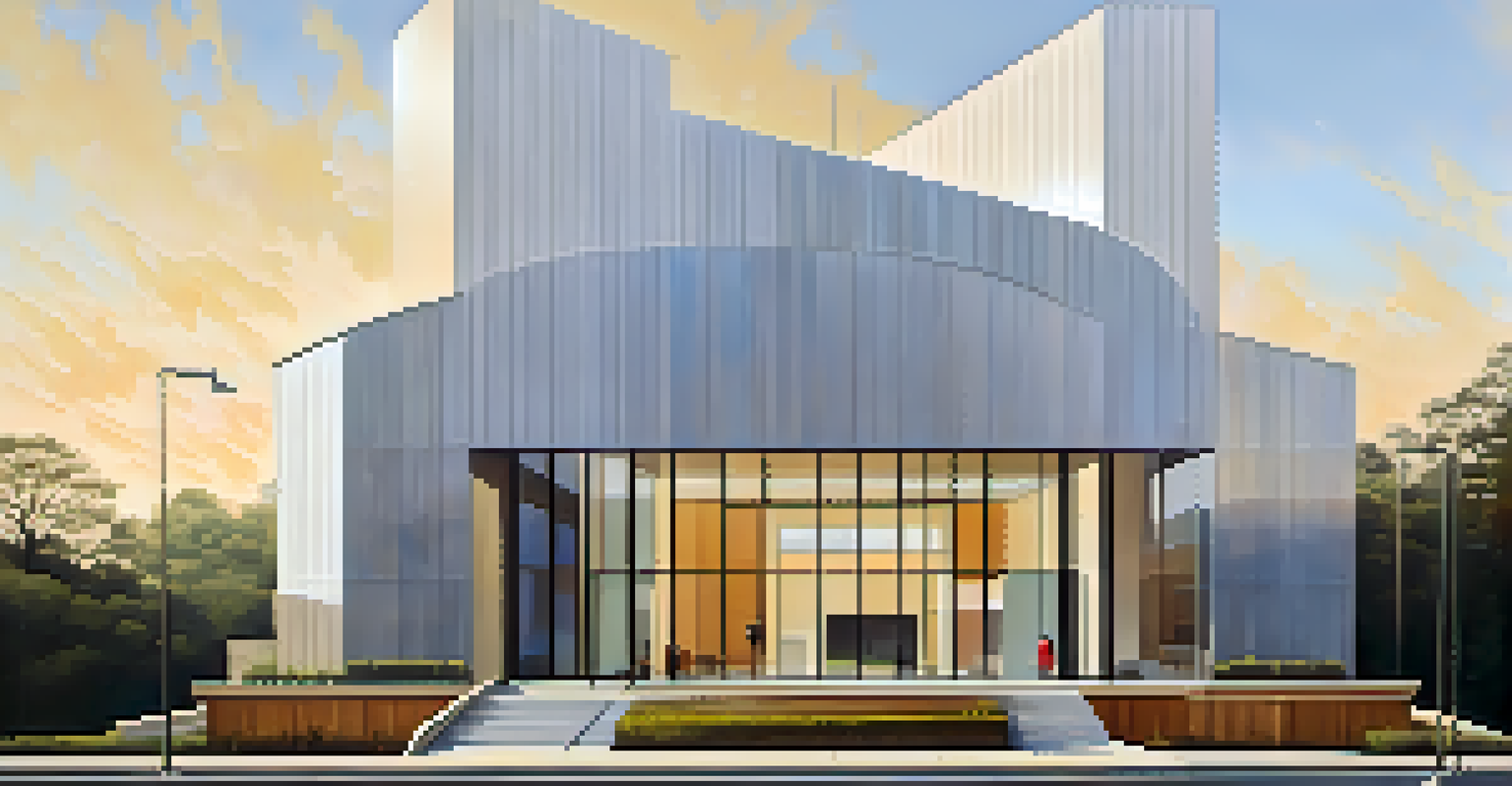The Architectural Styles of Historic Churches in Atlanta

Introduction to Atlanta's Historic Churches
Atlanta is home to a rich tapestry of historic churches, each with its own unique architectural style. From Gothic Revival to Neoclassical, these structures reflect the city’s cultural and historical evolution. As you stroll through the streets, it's fascinating to see how each church tells a story through its design and construction.
Architecture is the learned game, correct and magnificent, of forms assembled in the light.
These churches not only serve as places of worship but also as landmarks that capture the essence of Atlanta's community. They stand as testaments to the artistry and craftsmanship of their time, inviting visitors to appreciate both their beauty and significance. Exploring these buildings offers a glimpse into the past and the diverse influences that shaped the city.
In this article, we'll delve into various architectural styles found in Atlanta's historic churches, highlighting key features, notable examples, and the stories behind them. Whether you're an architecture enthusiast or just curious, there's something here for everyone.
Gothic Revival: A Touch of the Divine
The Gothic Revival style, characterized by its pointed arches, ribbed vaults, and flying buttresses, evokes a sense of grandeur and spirituality. In Atlanta, churches like the Cathedral of St. Philip stand as prime examples of this style, showcasing intricate stained glass windows and soaring ceilings. These features not only capture the eye but also enhance the worship experience, drawing the gaze upward.

This architectural style emerged in the 19th century, inspired by medieval European cathedrals. The revival was part of a broader movement that sought to reconnect with the spiritual roots of Christianity through architecture. In Atlanta, the churches built during this period reflect a deep desire for an aesthetic that inspires reverence and awe.
Diverse Architectural Styles
Atlanta's historic churches showcase a variety of architectural styles, each reflecting the city's cultural evolution and storytelling through design.
Visitors to these Gothic Revival churches often find themselves transported to another time, where the architecture seems to speak of divine presence. The combination of artistry and spirituality creates a unique environment that continues to attract worshippers and tourists alike.
Neoclassical Style: Order and Elegance
Neoclassical architecture in Atlanta is marked by its emphasis on symmetry, columns, and grandeur, reminiscent of ancient Greece and Rome. One notable example is the First Congregational Church, which features a stunning portico supported by tall columns. This design not only conveys strength and stability but also reflects the ideals of democracy and community.
A building is not just a place to be, but a way to be.
Emerging in the late 18th century, the Neoclassical style aimed to revive the classical principles of beauty and harmony. In Atlanta, churches built in this style often serve as community centers, reinforcing the idea of gathering spaces for worship and fellowship. The clean lines and balanced proportions of Neoclassical churches invite a sense of calm and order.
As you explore these buildings, you may notice how the architectural elements promote a welcoming atmosphere. The elegance of Neoclassical churches continues to resonate, making them beloved landmarks in the city.
Romanesque Revival: Strength and Solidity
The Romanesque Revival style is characterized by its round arches, thick walls, and robust construction, evoking a sense of strength and permanence. Churches like the St. Mark United Methodist Church showcase these features beautifully, with their heavy stone facades and intricate carvings. This style, popular in the late 19th century, often incorporates decorative brickwork and detailed stonework.
This architectural approach was influenced by Romanesque designs from the 11th and 12th centuries, reflecting a desire to convey stability and reliability. The churches built in this style often become community anchors, symbolizing endurance through both good times and bad. The use of rich materials and craftsmanship makes these structures stand out in their neighborhoods.
Significance of Preservation
Efforts to preserve these churches are vital for maintaining Atlanta's cultural heritage and honoring the traditions associated with each building.
Visitors are often struck by the imposing presence of Romanesque churches, which seem to invite reflection and contemplation. They serve not only as places of worship but as reminders of the strength of community and faith.
Eclecticism: A Blend of Styles
Eclectic architecture in Atlanta often features a mix of styles and influences, resulting in unique and visually striking churches. This approach allows for creativity and innovation, as seen in places like the Atlanta Metropolitan Cathedral. Here, you might find elements of Gothic, Romanesque, and even modern design all harmoniously combined.
The eclectic style emerged as architects sought to break away from rigid traditional forms, embracing a more personalized approach to design. This flexibility allows churches to reflect their congregations' diverse backgrounds and values. Each building becomes a canvas for artistic expression, showcasing the community's spirit.
As you explore these eclectic churches, you'll notice how they challenge conventional boundaries, inviting curiosity and admiration. Their distinctive appearances make them memorable landmarks that enrich Atlanta's architectural landscape.
Modernist Influence: Redefining Spaces
Modernist architecture in churches often emphasizes simplicity, functionality, and the use of new materials. In Atlanta, churches like the Trinity United Methodist Church embrace this style with clean lines and open spaces, creating an inviting atmosphere for worshippers. The design often encourages a sense of community and connection, breaking down barriers between clergy and congregation.
Emerging in the early 20th century, modernism sought to reflect contemporary life and values, moving away from ornate and historical styles. This shift is evident in the way modern churches integrate with their surroundings, often using glass and steel to create a sense of transparency and light. The result is a fresh approach that resonates with today's spiritual seekers.
Community and Connection
These churches serve as important gathering spaces that foster community, worship, and reflection, contributing to the city's identity.
Visitors to modernist churches often appreciate the focus on community and accessibility, as these designs foster engagement and interaction. The architectural choices reflect a commitment to inclusivity, making these spaces relevant for modern worshippers.
Preservation Efforts: Honoring the Past
Preserving historic churches in Atlanta is essential for maintaining the city's cultural heritage. Organizations and local communities work tirelessly to protect these architectural gems from the pressures of urban development. Efforts include restoration projects, fundraising, and advocacy to ensure that these churches remain vibrant parts of the community.
Many historic churches have undergone renovations that respect their original designs while making them functional for modern use. These preservation efforts not only safeguard architectural styles but also honor the stories and traditions associated with each building. They serve as reminders of the faith and dedication of those who came before us.

Visitors can engage with these churches through tours and community events, fostering a deeper appreciation for their history and significance. By supporting preservation initiatives, we can help ensure that future generations can experience the beauty and inspiration of Atlanta's historic churches.
Conclusion: Atlanta's Churches as Cultural Landmarks
Atlanta's historic churches are more than just places of worship; they are cultural landmarks that reflect the city's rich history and diversity. Each architectural style tells a unique story, inviting exploration and appreciation from both locals and visitors. Whether you're drawn to the soaring heights of Gothic Revival or the clean lines of Modernism, there's beauty to be found in every corner.
As we admire these structures, we also recognize their significance in fostering community and connection. They serve as gathering spaces for worship, celebration, and reflection, enriching the lives of those who enter their doors. The architectural styles present in Atlanta's churches are a testament to the city's evolving identity and values.
In conclusion, exploring the architectural styles of historic churches in Atlanta offers a delightful journey through time. These buildings not only inspire awe but also remind us of the enduring power of faith and community in shaping our lives.